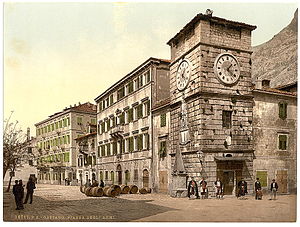- Architecture of Montenegro
-
Part of a series on the Culture of Montenegro 
Architecture Cinema Cuisine Literature Music Radio Television
Montenegro Portal
Characteristics
Montenegro has a number of significant cultural and historical sites, including heritage sites from the pre-Romanesque, Gothic and Baroque periods.
The Montenegrin coastal region is especially well known for its religious monuments, including the Cathedral of Saint Tryphon[1], the basilica of St. Luke (over 800 years), Our Lady of the Rock (Škrpjela), the Savina Monastery, the Cetinje Monastery and others.
This area, sometimes called Venetian Montenegro, is full of Venetian architecture, mainly in Cattaro (Kotor) and Perasto (Perast): the ancient city of Cattaro is listed on the UNESCO World Heritage list.
The Byzantine influence in architecture and in religious artwork is especially apparent in the country's interior.
The majority of architecture of Montenegro is Byzantine, Latin or Venetian (Gothic, Romanesque, Baroque) and Ottoman.
The architecture of "Storica Cattaro" (venetian for "Stari Kotor")
Four centuries of Venetian domination have given the city the typical Venetian architecture, that contributed to make Kotor a UNESCO world heritage site.[2]
The Venetian fortification system of Kotor (that venetians called "Cattaro"), which protects it from the sea, is actually a wall 4.5 km long, 20 m high and 15 m wide, and is preserved as one of the world's historic values by the UNESCO.
The construction of the ramparts were built and rebuilt up to the XVIII century. The oldest town gate of Cattaro, of the three existing in the town, is the “South” gate which was partially constructed in the IX century. The “North” and the “Main” gates were build in the Renaissance style by the first half of the XVI century. The most representative monument of Roman architecture in the Adriatic is the magnificent Cathedral of Saint Tryphon, constructed in 1166 and built on the remains of the former temple from the IX century. There are the remains of the frescos from the XIV century and the valuable treasury with domestic and Venetian golden works dating from the XIV to the XX century.
Besides the Cathedral, in the heart of the old town, there are magnificent examples of sacral architecture originating from XII till XX century:
- The Romanic church of St. Lucas was built in 1195, while the Romanic church of St. Ana dates from the end of the XII century and has frescos dating back from the XV century.
- The Romanic church of St. Mary dates from 1221. The church contains the remains of a monumental fresco painting as well as an early Christian baptistry.-
- The Gothic church of St. Mihovil was built on the remains of the Benediction monastery from the VII century with frescos dating back from XV century.
- St. Clara's church dates from the XIV century with the extremely beautiful marble altar, the work of Francesco Cabianca, from the XVIII century.
- The Church of Lady of Health originates from the XV century.
- The Orthodox Church of St. Nicolas was built by the beginning of the XX century with a valuable collection of icons.
There are also numerous palaces in venetian style in the Kotor Stari Grad:
The "Drago palace" with Gothic windows from the XV century; the "Bizanti palace" from the XVII century; the "Pima palace", with typical Venetian renaissance and baroque forms from the XVI century; the "Grubonia palace" with the built-in emblem of the old Kotor's pharmacy established in 1326; the "Gregurina palace", from the XVII century, which today contains the Naval museum, and finally the "Clock tower", from the XVI century, with the medieval pillory just beside it.
Notes
- ^ http://www.discover-montenegro.com/St_Tryphon's_Cathedral.htm St. Tryphon'c Cathedral
- ^ "Natural and Culturo-Historical Region of Kotor". Unesco World Heritage Convention. http://whc.unesco.org/en/list/125. Retrieved 2010-12-08.
See also
- Venetian Albania
- Cattaro Cathedral
- Natural and Culturo-Historical Region of Kotor
- Cetinje Monastery
- Sveti Stefan
- Perast
- Budva
Bibliography
- Realm of the Black Mountain: A History of Montenegro by Elizabeth Roberts (Hurst & Co, 2007) ISBN 978-1-85065-868-9
 Montenegro topics
Montenegro topicsHistory Praevalitana · Duklja · Principality of Zeta · Sanjak of Montenegro, Ottoman Empire · Principality of Montenegro · Kingdom of Montenegro · Kingdom of Yugoslavia · Zeta Banovina · Kingdom of Montenegro (1941-1944) · World War II · Socialist Republic of Montenegro · Montenegrin independence referendum · MontenegroGeography Topography · Mountains · Extreme points of Montenegro · Islands · Rivers · Lakes · Climate · Protected areas · Flora · FaunaPolitics Economy Euro · Montenegrin perper · National Bank · Education · Communications · Tourism · Transport · CompaniesMilitary Symbols Demographics Administrative divisions · Cities · Human rights · Postal codes · Languages · Religion · Montenegrins · List of MontenegrinsCulture Academy · Architecture · Art · Cinema · Music · Cuisine · Montenegrin language · Literature • Poets · Philosophy · Folklore · Media (Television • Radio) · SportWikiProject · PortalArchitecture of Europe By country Albania · Armenia · Austria · Azerbaijan · Belarus · Belgium · Bosnia and Herzegovina · Bulgaria · Croatia · Cyprus · Czech Republic · Denmark · Estonia · Finland · France · Georgia · Germany · Greece · Hungary · Iceland · Ireland · Italy · Kazakhstan · Latvia · Lithuania · Luxembourg · Macedonia · Malta · Moldova · Montenegro · Netherlands · Norway · Poland · Portugal · Romania · Russia · Serbia · Slovakia · Slovenia · Spain · Sweden · Switzerland · Turkey · Ukraine · United Kingdom (England · Scotland)History Ancient Greek · Roman · Byzantine · Pre-Romanesque · Romanesque · Romano-Gothic · Gothic · Renaissance · Baroque · Biedermeier · Classicism · Neoclassical · Historicism · Gründerzeit · Gothic Revival · Neo-Renaissance · Neo-Baroque · Rationalism · Modernisme · Art Nouveau · Expressionism · Modern · PostmodernCategories:- Montenegrin architecture
- Architecture stubs
Wikimedia Foundation. 2010.


